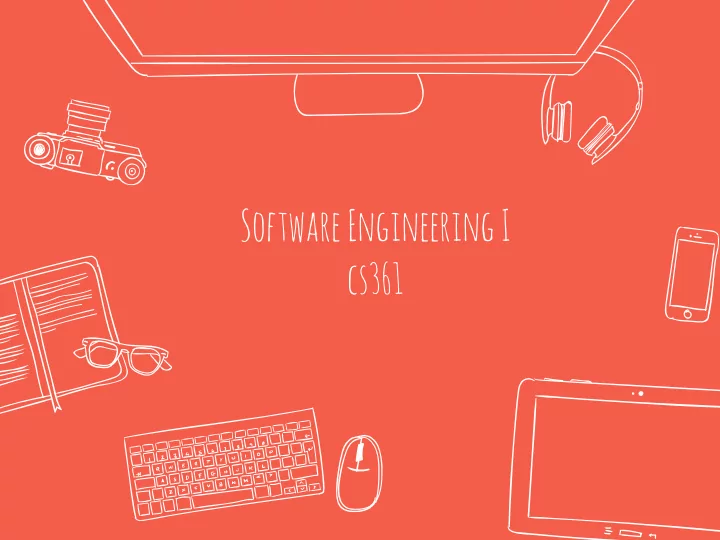

Software Engineering I cs361
Announcements ✖ Writing Assignment 3 ✖ http:// web.engr.oregonstate.edu/ ~hiltonm/classes/cs361/ WritingAssignments/ WritingAssignment3.pdf
Class Diagrams
Attribution Much of this material inspired by a great slides from Steve Easterbrook, available here: http://www.cs.toronto.edu/~sme/ CSC340F/slides/11-objects.pdf also some material taken from here: http://web.stanford.edu/class/cs193j/ LectureThree.pdf
Object Terminology Review Any entity which mirrors the existence of a real world entity is an Object. Examples:
Object Terminology Review Any entity which mirrors the existence of a real world entity is an Object. Examples: Person, Student, Car, Playing Card, etc.
Object Terminology Review Objects Contain: -attributes (variables) -functionality (methods) Objects can have properties or be acted upon
Object Terminology Review A description of an Object is called a class Examples:
Encapsulation ✖ Objects allow data and functionality to be bundled together. ✖ Additionally, access to the data may be restricted to some of the objects components
Inheritance ✖ Allows one Class to automatically “assume” the attributes of another class ✖ Defines an “is a” relationship for classes
Polymorphism ✖ The ability to send the same message (call a method) to an Object, without knowing how the receiver (Object) will implement the message.
Building an Object Oriented Model Our model should: represent people, things and concepts show connections and interactions show enough detail to evaluate designs maintain value after design phase
Object Oriented Analysis Background -Model the requirements in terms of objects and services Motivation -OO is (claimed to be) more ‘natural’ -OO emphasizes importance of well-defined interfaces between objects.
Nearly Anything can be an object…
Nearly Anything can be an object… ✖ External Entities e.g. ✖ Organizational people, devices, other systems. Unites e.g. division, group, team, etc ✖ Things e.g. reports, displays, signals, etc ✖ Places e.g. manufacturing floor, loading dock, game board, ✖ Occurrences or etc Events e.g. transfer of ✖ Structures e.g. sensors, resources, a control actions, etc computers, etc ✖ Roles people who interact with the system
THINGS THAT SHOULD NOT BE AN OBJECT ✖ Procedures: e.g. print, draw, deal, etc ✖ Attributes: e.g. blue, 50Mb, etc
Classes A class describes a group of objects with: similar properties (attributes) common behavior (operations) common relationships common meaning
Example Class: employee: has a name, employee#, department an employee is hired, fired; an employee works in one or more projects
:Employee name employee# department hire() fire() assignProject()
Name (mandatory) :Employee Attributes (optional) name employee# department Operations (optional) hire() fire() assignProject()
How to find classes ✖ Look for nouns in user stories ✖ Review background information ✖ It’s better to start with too many and discard later
Selecting Classes Discard classes for concepts which: - Are beyond the scope of the analysis - Refer to the system as a whole - Duplicate other classes - External entities should not be included as classes
Cold & Yourdon’s critera - Retained information : will the system need to remember info about this class? - Needed Services: Do these objects have identifiable operations that change values - Multiple Attributes: A single attribute class may be an attribute - Common Attributes and Operations: Does the class share attributes and operations will all of its objects
Objects vs Classes The instances of a class are called objects. Jane Doe:Employee name: Jane Doe employee#: 123-456 department: Software Dev hire() fire() assignProject()
Associations Objects do not exist in isolation UML supports: -Association -Aggregation and Composition -Generalization -Dependency -Realization
Class associations :Employee :Office name room #: employee# # of desks: 1 Works in 0..* department hire() add_Employee() fire() remove_Employee() assignProject()
association Classes :car :person VIN name Year Made address 1 owns 0..* Mileage DriversLicenseNumber … … :title yearBought price initialMileage …
Aggregation and Composition ✖ Aggregation: This is the “Has-a” or “Whole/part” relationship ✖ Composition implies ownership:
Aggregation and Composition Example 1 :engine Composition 1 :car 0..1 :person 1 driver Aggregation
Generalization ✖ Subclasses are more specific versions of superclasses ✖ Subclasses inherit attributes, associations, & operations from the superclass ✖ Subclasses can override an inherited aspect ✖ Superclass are abstract if they have no instances
Generalization :student name gpa :undergrad :masters :PhD year m eng dissertation major theis advisor minor
http://agilemodeling.com/artifacts/classDiagram.htm
http://www.uml-diagrams.org/class-diagrams-overview.html
http://yuml.me/diagram/scruffy/class/samples
:car :person owns 1 0..1 VIN name Year Made address Mileage DriversLicenseNumber 1 … … :title yearBought price initialMileage … :sedan :SUV :engine trunkSize isFourWheelDrive
Feedback
Credits Special thanks to all the people who made and released these awesome resources for free: ✖ Presentation template by SlidesCarnival ✖ Photographs by Unsplash
Recommend
More recommend